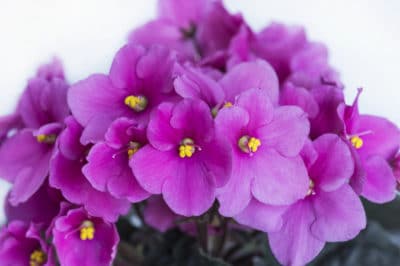Best Growing Conditions for African Violets
African violets need plenty of indirect bright light, the right potting soil, fertilizer, adequate humidity and proper watering to bloom. If any of these factors is out of kilter, your violets will produce leaves but no flowers. A west-or south-facing windowsill, pots with commercial African violet mix and low-nitrogen/high phosphorus fertilizer come first. Mist one or more times a day. Water to keep soil moist.
How African Violets Bloom
Most properly grown African violets will have a single crown (species varieties and trailers are exceptions). They should not have suckers – the beginnings of small new crowns that look like small leaves along the stem. The plants produce flowers from new growth, usually the first three rows of leaves. If your violet has four or five rows of leaves, it will bloom poorly or not at all.
Plant Maturity and Bloom
African violets, like many flowering plants, will not bloom until they are mature. Depending on the variety, that will take about six to nine months. When you buy an African violet that is in bloom, it has obviously reached maturity. However, if you don’t give it the proper conditions, even though it is mature it will not continue to bloom.
Reliable Bloomers
African violets with single flowers and plain foliage often are the most reliable bloomers. Hybrids may have been bred for characteristics other than bloom. These are generally reliable:
- Colonial Broome
- Christening Gown
- Fun Trail
- Harbor Blue
- Ness’ Foggy Blues
- Phantom Flash
- The Alps
Flower Buds on African Violets
Just because an African violet has flower buds, that does not guarantee blooms. Low humidity and inadequate watering are two possible culprits, as either can cause the buds to die. If you use self-watering pots, make sure to check the soil periodically to make sure it is moist. Powdery mildew and cyclamen mites may damage buds and prevent them from developing into flowers.
When an African Violet Won’t Bloom
If your African violets won’t bloom and you are following all the proper cultural and environmental practices, you can try tapping the pot against the counter several times. This miniature “earthquake” sometimes shocks the plants into bloom. Repotting is another possible strategy. Some plants are simply shy bloomers – if that’s the case, discard and get another plant.
